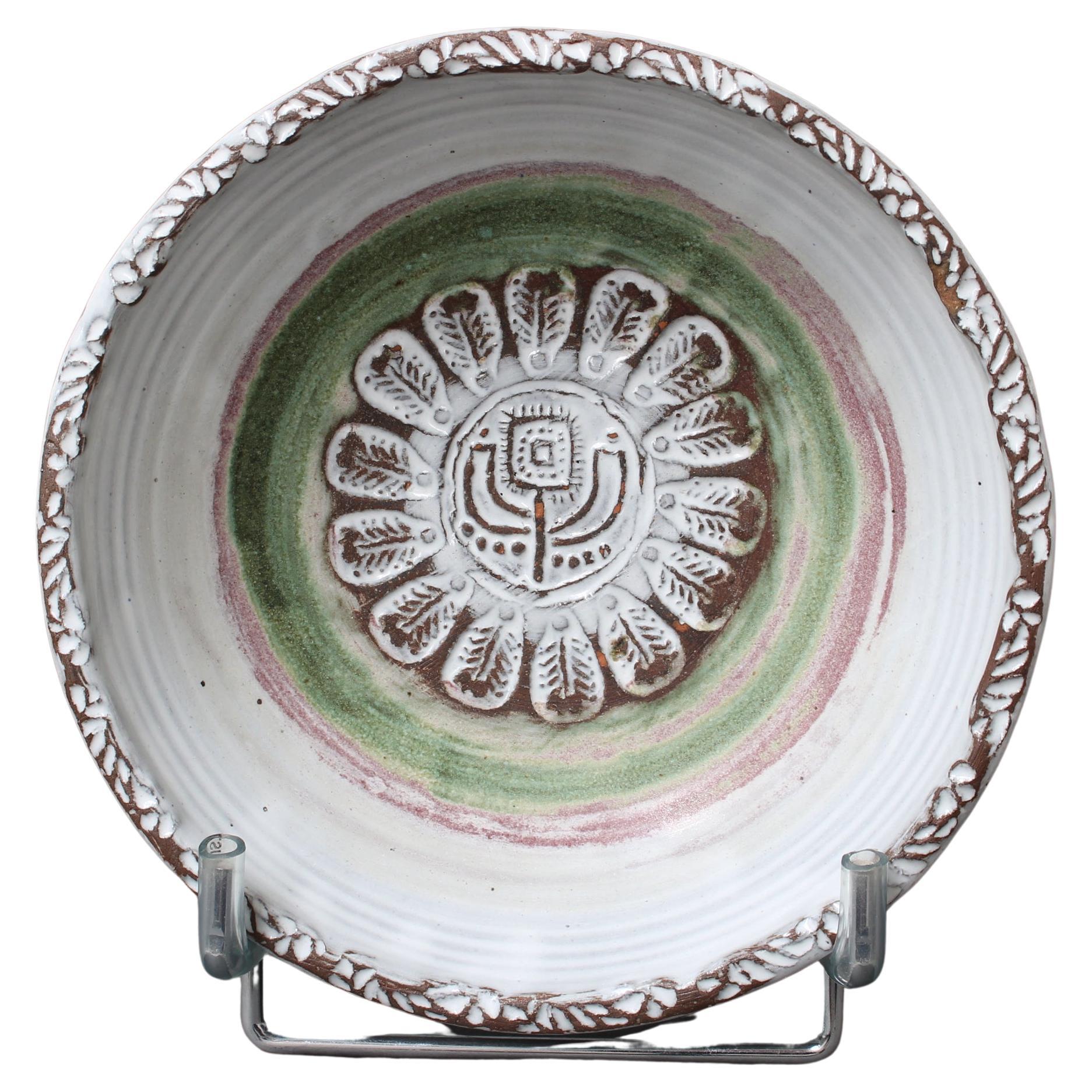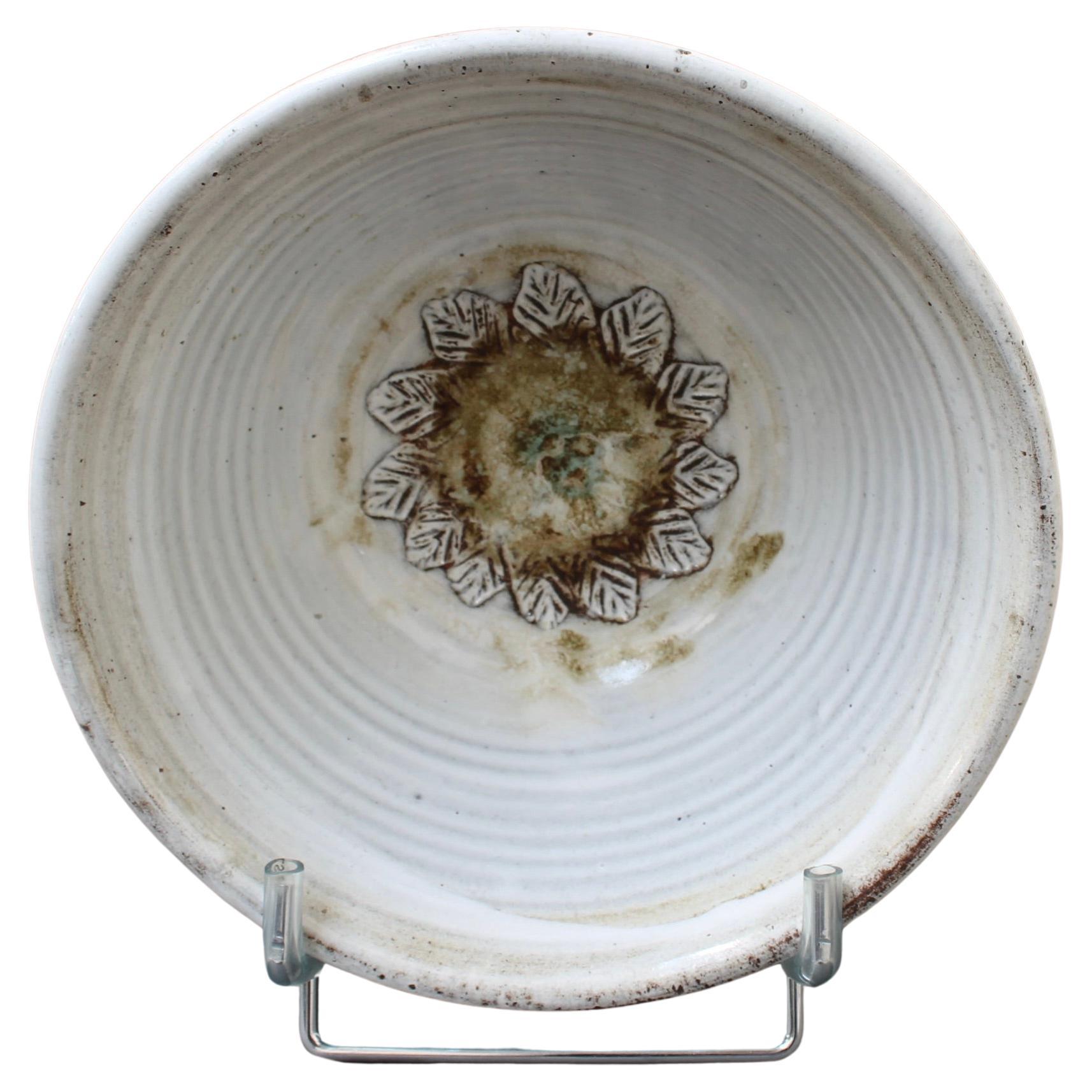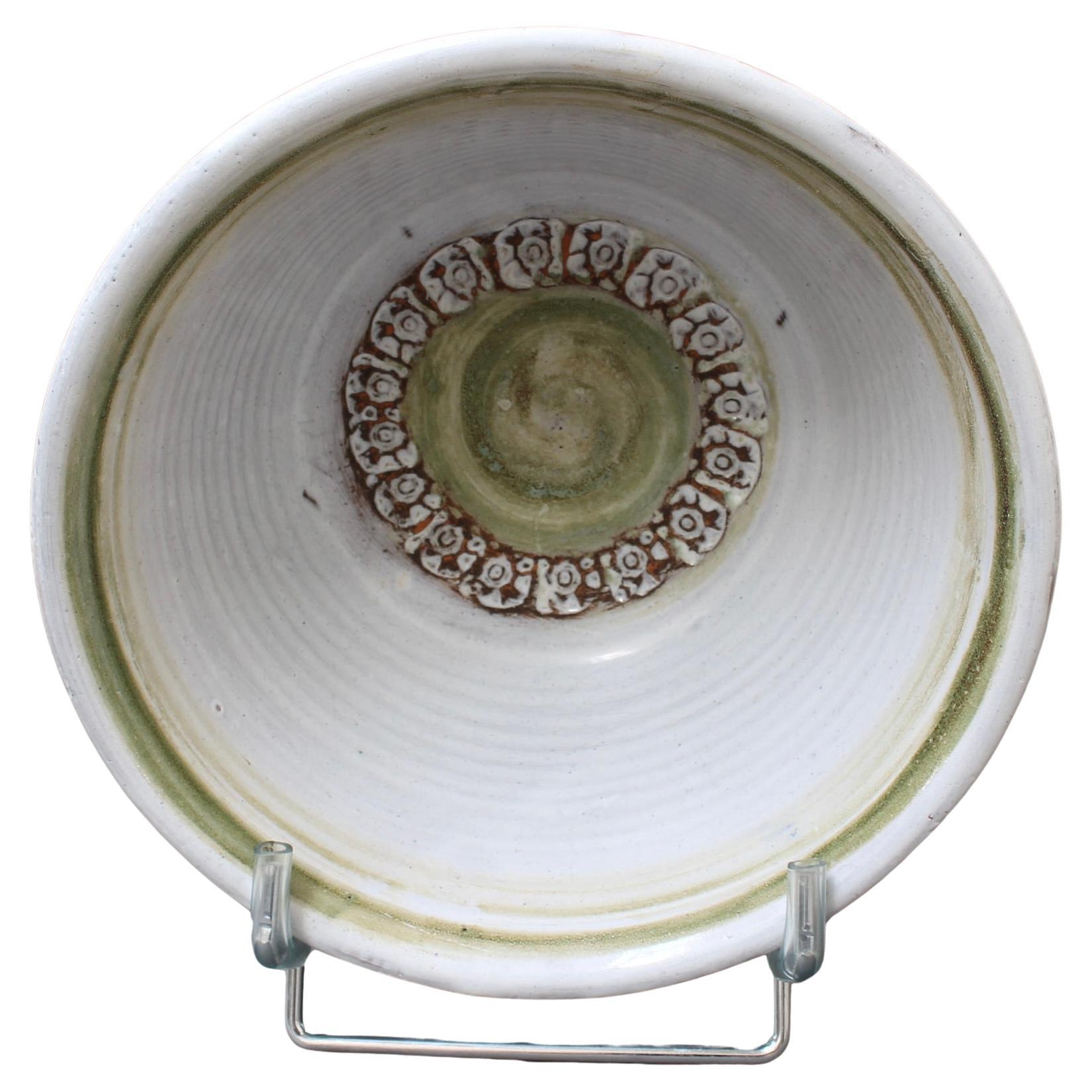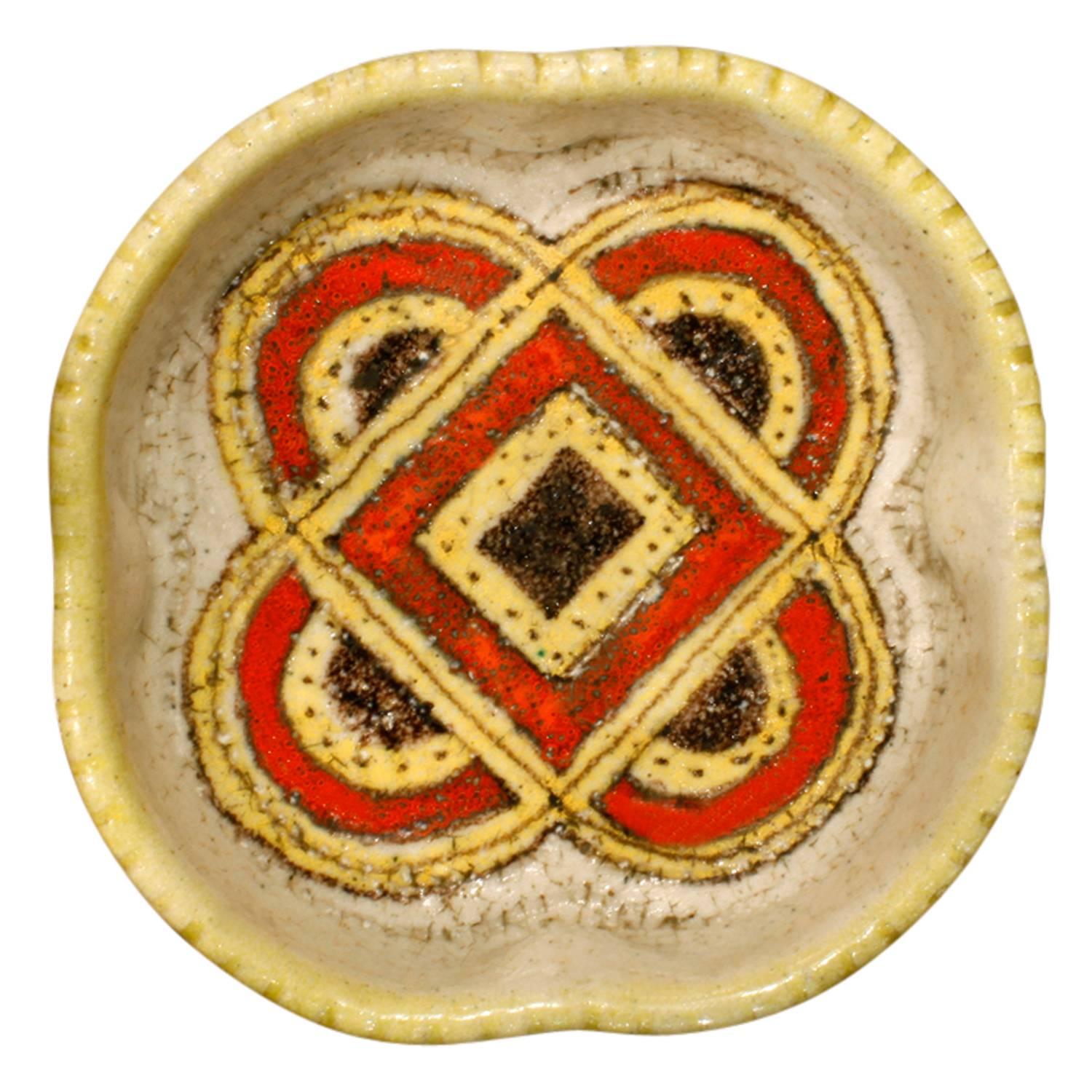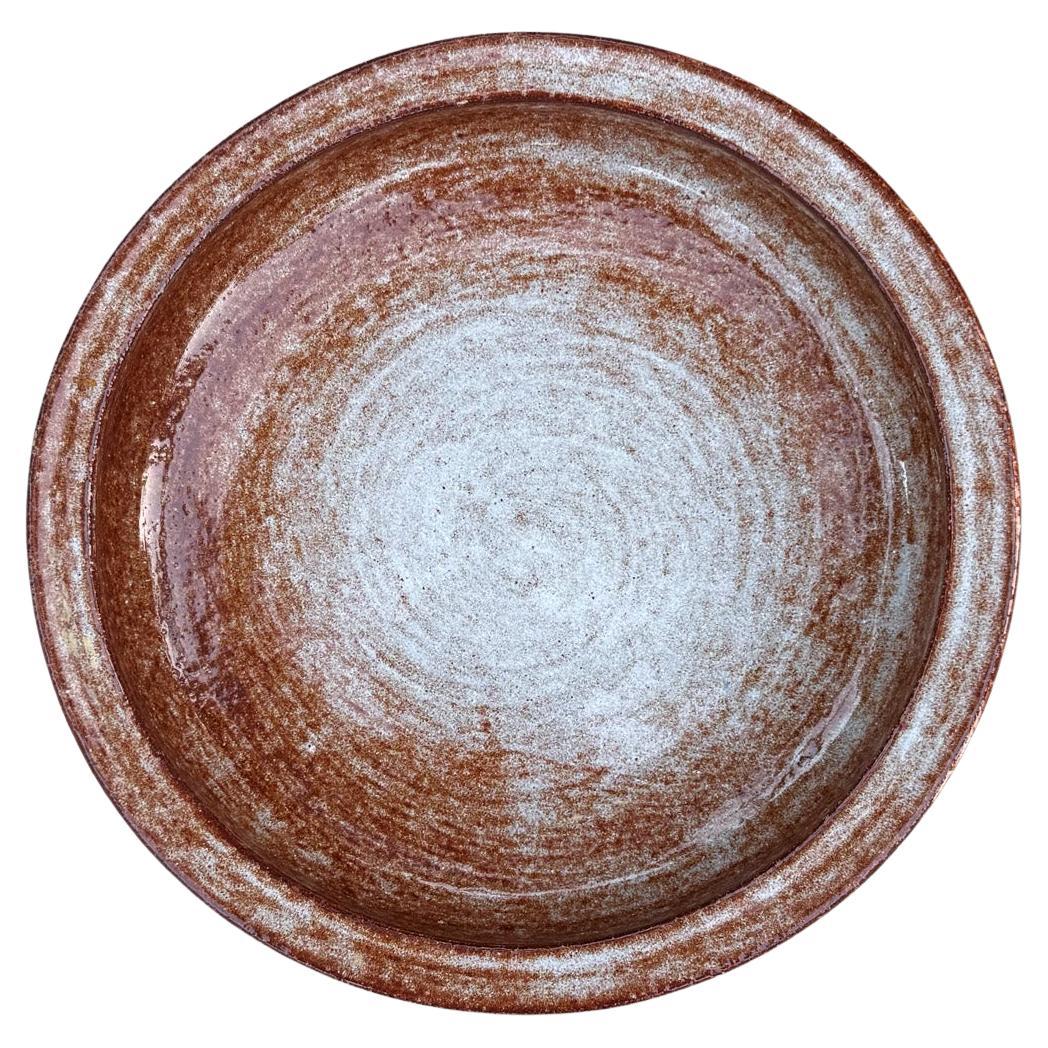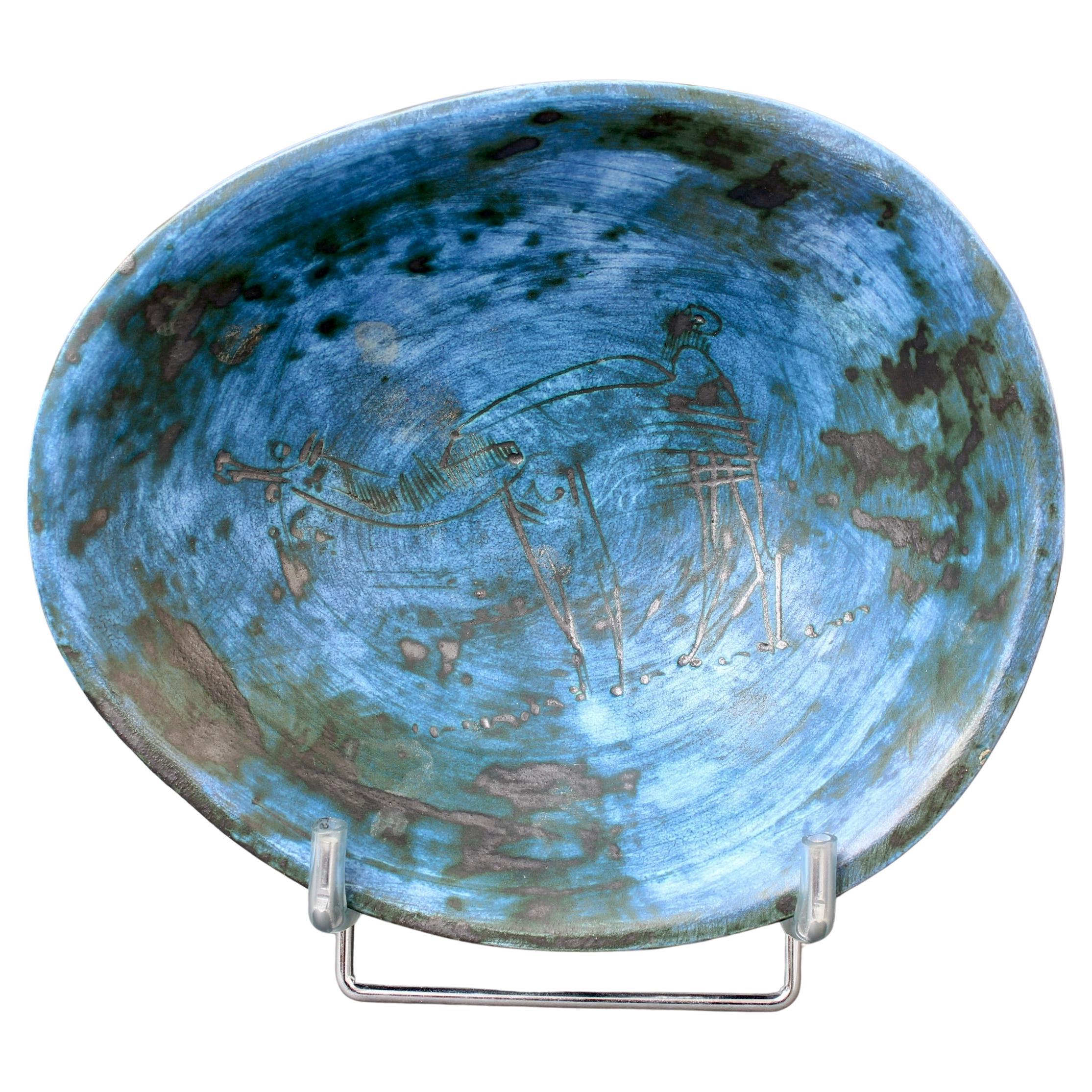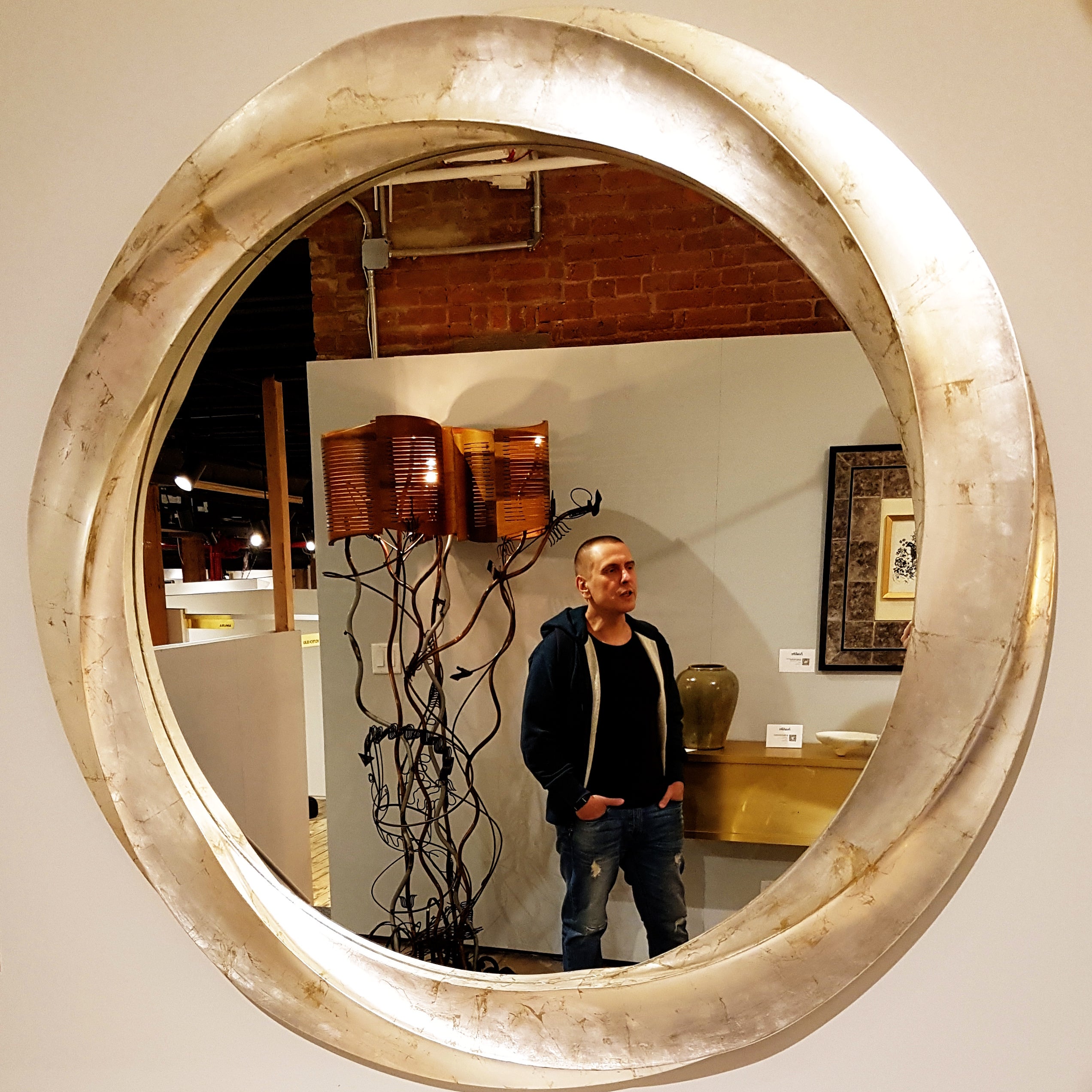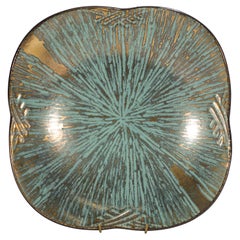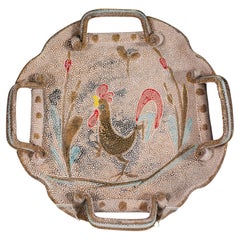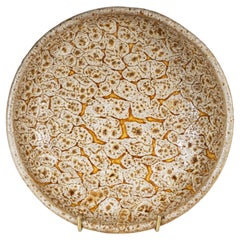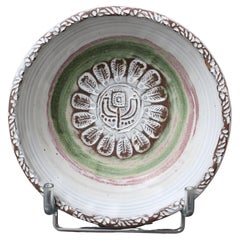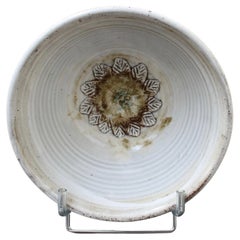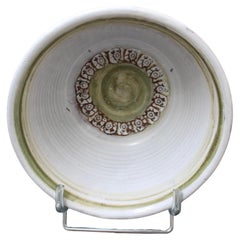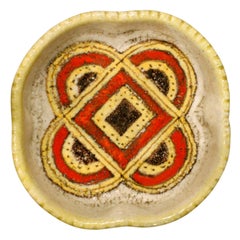Items Similar to Linn Phelan Large Ceramic Decorative Bowl, Early American Studio Pottery
Video Loading
Want more images or videos?
Request additional images or videos from the seller
1 of 10
Linn Phelan Large Ceramic Decorative Bowl, Early American Studio Pottery
$1,250
£954.80
€1,097.18
CA$1,784.38
A$1,956.44
CHF 1,021.64
MX$23,543.26
NOK 12,876.09
SEK 12,106.84
DKK 8,193.89
About the Item
Vintage ceramic decorative plate or bowl features a playful Modernist design of a chicken, hand-painted in off-white textured lava glaze on mocha and espresso brown drip glaze background. The rim of the plate is accented with the lava glaze border with drip elements. The plate is equipped with the original mounting hardware on the bottom; it can be displayed either on a wall or as a shelf or table decor.
The bowl is signed on the bottom with Linn L Phelan impressed into clay and with the original paper sticker. The sticker provides the design number and describes the plate as "12" PLATE ALFRED SHALE glaze Trail Chicken, L. L. Phelan, Almond, N.Y." Alfred shale is a clay shale in Alfred, NY, a small town in Allegany County, Western New York State, that is home to Alfred University and Alfred University's New York State College of Ceramics; the shale was historically mined for clay that was used in ceramics, tiles, and brick production.
Linn Lovejoy Phelan (1906-1992) was a renowned American ceramic artist, who operated famous Rowantrees and Linwood Pottery in Maine. He studied art in Bevier School of Art of the Rochester Athenaeum and Mechanics Institute (now Rochester Institute of Technology) in Rochester, New York, in 1928, and received his BFA in Ceramic Art in Ohio State University, Columbus, Ohio, in 1932. While attending Ohio State University, Phelan took "Ceramic Art: Survey of the Field" class, taught by Arthur Baggs. After Phelan left the school, he corresponded with Baggs, and in late 1930s Phelan wrote to Baggs of his experiences in helping to start up what becomes Rowantrees Pottery of Blue Hill, Maine. Arthur E. Baggs (1886-1947) studied at Alfred University in 1903-1905 and 1910-1911 with Dr. Charles F. Binns, who was considered "the father of American ceramic art"; Baggs worked at Marblehead Pottery and Cowan Pottery Studio, and became the head of the Ceramic Art Division of the Fine Arts Department at Ohio State University in 1928. Examples of Baggs work are in the collections of The Metropolitan Museum of Art in New York; Museum of Fine Arts, Boston; Everson Museum of Art in Syracuse, NY; and Columbus Museum of Art in Ohio. Baggs was an extremely influential figure in early American ceramics; he was given the Binns medal for outstanding achievement, made a Fellow of the American Ceramic Society and a member of Keramos. Through Baggs Phelan was exposed to the foundations of technical creativity and advancements in ceramic art in Alfred University, as well as the early 1900s studio pottery movement in America, linking the Arts and Crafts phase of studio pottery to Modernist movement.
In 1940s Phelan started teaching ceramics at School of American Craftsman (SAC), founded by Aileen Osborn Webb at Darthmouth College in 1944; SAC moved to Alfred University in Alfred, New York, in 1946, and to Rochester Institute of Technology (RIT) in 1950s. In 1940s SAC faculty included Edwin Blanchard Brown, Ernest Frank Brace, Laurits Eichner, Philip Morton, Charles Reese, Ethel Mitchell, Robert Savage, Thomas Mclure, along with Linn Phelan and another renowned ceramist, Herbert Sanders; in early 1950s new additions to the SAC faculty included Copenhagen-trained woodworker Tage Frid and metalworker John Prip, Danish silversmith Hans Christensen, as well as Olin Russum, Vienna-educated member of Austrian "Werkbund" Mitzi Otten, design teacher Fred Meyer, and Bauhaus-trained ceramist Frans Wildenhain; sculptor and woodworker Wendell Castle joined SAC faculty in early 1960s. Through his experiences with SAC Phelan participated in guiding and supporting a new generation of American artists, designers, and craftsman; many SAC students went on to achieve national reputation.
In 1950s, in years after SAC moved to Rochester, Phelan made a decision to return to Allegany County, where he bought a house while teaching at Alfred University, to continue his independent studio work. Phelan reestablished Linwood Pottery in Almond, NY, and continued to operate it for the rest of his life. He was involved in teaching art at Alfred-Almond Central School in Almond, NY, in 1950s-1960s, contributed to cultural initiatives in Maine and New York, and served as president of the New York State Art Teachers Association. Phelan's work can be found in both public and private collections nationwide.
- Creator:Linn Lovejoy Phelan (Artist)
- Dimensions:Height: 2 in (5.08 cm)Diameter: 12 in (30.48 cm)
- Style:Mid-Century Modern (Of the Period)
- Materials and Techniques:
- Place of Origin:
- Period:
- Date of Manufacture:1950s-1960s
- Condition:Wear consistent with age and use.
- Seller Location:Clifton Springs, NY
- Reference Number:1stDibs: LU4421143771622
Roman Erlikh
Roman Erlikh is a professional woodworker with over 20 years’ experience. Roman Erlikh Studio creates bespoke and limited edition contemporary furniture and art objects. His first furniture collections were inspired by traditional Art Deco and Biedermeier styles interpreted through a modern lifestyle demands. Stepping away from merely utilitarian view of everyday objects, his recent collections are filled with meaningful textual context while incorporating traditional and modern woodworking techniques. Roman is using practical function as a common denominator to create emotionally charged art objects, blurring the boundary between art and function. While appreciating possibilities of ordinary materials, Roman is developing new mixed media multilayered composite varnishes and utilizes decorative gilding and mica veneer to actively engage ambient light, giving an additional aspect to relation of his objects to their environment. The decision to work in custom format was based on environmental concerns and opposition to culture of mass production and pure consumerism. The choice of materials was heavily influenced by sustainability and environmental concerns. All objects are made locally in the Brooklyn Navy Yard workshop. Elimination of storage and transportation needs for mass-produced furniture in lieu of creating a custom made objects on demand allows us to reduce waste of materials and energy.
About the Seller
5.0
Platinum Seller
Premium sellers with a 4.7+ rating and 24-hour response times
Established in 2011
1stDibs seller since 2019
236 sales on 1stDibs
Typical response time: <1 hour
- ShippingRetrieving quote...Shipping from: Clifton Springs, NY
- Return Policy
Authenticity Guarantee
In the unlikely event there’s an issue with an item’s authenticity, contact us within 1 year for a full refund. DetailsMoney-Back Guarantee
If your item is not as described, is damaged in transit, or does not arrive, contact us within 7 days for a full refund. Details24-Hour Cancellation
You have a 24-hour grace period in which to reconsider your purchase, with no questions asked.Vetted Professional Sellers
Our world-class sellers must adhere to strict standards for service and quality, maintaining the integrity of our listings.Price-Match Guarantee
If you find that a seller listed the same item for a lower price elsewhere, we’ll match it.Trusted Global Delivery
Our best-in-class carrier network provides specialized shipping options worldwide, including custom delivery.More From This Seller
View AllCarstens Tönnieshof Square Bowl, West Germany Ceramics, 1960s
By Carstens Tönnieshof
Located in Clifton Springs, NY
Vintage bowl was made by Carstens Tönnieshof with complex graphic pattern in gold on teal or celadon glaze background. The bowl has monochromatic black glaze on the bottom surfaces ...
Category
Mid-20th Century German Organic Modern Decorative Dishes and Vide-Poche
Materials
Gold
$240 Sale Price
20% Off
Douglas Ferguson for Pigeon Forge Crater Glaze Bowl #3, American Studio Pottery
Located in Clifton Springs, NY
Vintage hand-thrown bowl features complex Crater glaze in mocha and latte brown colors. Minimal color palette and streamlined shape of the piece allow the textured glaze with variations from semi-matte to high gloss to take the spotlight; slightly asymmetrical rim adds hand-crafted, Organic Modern mood to the bowl's design.
The bowl is personally signed by Douglas Ferguson on the bottom with his name and "Pigeon Forge Pottery".
The Crater glaze has become one of the most recognizable glazes made by the Pigeon Forge Pottery. Often commonly referred to as "Volcanic" or "Lava" glaze, the Crater glaze was developed and made in several colors. We are offering a vase and 4 more bowls in different shapes by Douglas Ferguson, done in variations of Crater glazes, in separate listings.
Douglas Ferguson (1912-1999) was an established Tennessee pottery artist; he received a degree in Art Design Studies from Mars Hill College and worked in the Ceramic Research Laboratory for the Tennessee Valley Authority in Norris, TN, from 1935 to 1947, where he experimented with local clays. In 1946 he started Pigeon Forge Pottery in an old tobacco barn with his wife Ruth and Ernest Wilson, his colleague at the Ceramic Research Laboratory. He formulated many of his own glazes, including crystalline and Crater glaze.
In 1957 he created the Clingman Dome tea set, named by Ferguson for the highest peak in the Great Smoky Mountains, which the state of Tennessee presented to Queen Elizabeth. Ferguson became a member of the Southern Highland Craft Guild in 1948 and remained active until 1998, receiving Life Membership in 1991. He earned two awards from the Tennessee Arts and Crafts Festival in Nashville, received the Rotary Certificate of Distinguished Service, and was featured in books on Appalachian...
Category
Mid-20th Century American Mid-Century Modern Ceramics
Materials
Ceramic, Pottery
Fratelli Fanciullacci Majolica Bowl or Tray, Textured Glaze, Italy 1950s-1960s
By Fratelli Fanciullacci
Located in Clifton Springs, NY
Sculptural Modernist bowl or tray is decorated with hand-painted decor in pastel colors with gold accents on complex textured glaze background. Playfully shaped piece features four ...
Category
Mid-20th Century Italian Mid-Century Modern Ceramics
Materials
Gold
$340 Sale Price
20% Off
Douglas Ferguson for Pigeon Forge Crater Glaze Bowl #4, American Studio Pottery
Located in Clifton Springs, NY
Vintage hand-thrown bowl features complex Crater glaze in mocha, latte, and caramel brown colors. Minimal color palette and streamlined shape of the piece allow the textured glaze with variations from semi-matte to high gloss to take the spotlight; slightly asymmetrical rim adds hand-crafted, Organic Modern mood to the bowl's design.
The bowl is personally signed by Douglas Ferguson on the bottom with his name and "Pigeon Forge Pottery Tenn".
The Crater glaze has become one of the most recognizable glazes made by the Pigeon Forge Pottery. Often commonly referred to as "Volcanic" or "Lava" glaze, the Crater glaze was developed and made in several colors. We are offering a vase and 4 more bowls in different shapes by Douglas Ferguson, done in variations of Crater glazes, in separate listings.
Douglas Ferguson (1912-1999) was an established Tennessee pottery artist; he received a degree in Art Design Studies from Mars Hill College and worked in the Ceramic Research Laboratory for the Tennessee Valley Authority in Norris, TN, from 1935 to 1947, where he experimented with local clays. In 1946 he started Pigeon Forge Pottery in an old tobacco barn with his wife Ruth and Ernest Wilson, his colleague at the Ceramic Research Laboratory. He formulated many of his own glazes, including crystalline and Crater glaze.
In 1957 he created the Clingman Dome tea set, named by Ferguson for the highest peak in the Great Smoky Mountains, which the state of Tennessee presented to Queen Elizabeth. Ferguson became a member of the Southern Highland Craft Guild in 1948 and remained active until 1998, receiving Life Membership in 1991. He earned two awards from the Tennessee Arts and Crafts Festival in Nashville, received the Rotary Certificate of Distinguished Service, and was featured in books on Appalachian craftspeople by Bernice Stevens, Edward Dupuy and Helen Bullard. In the fall of 1952, Ferguson attended a ceramics symposium by international artists at Black Mountain College; in 1963 he participated in the American Craft Council and the Ceramic National exhibitions. In the 1970s - 80s Ferguson created a fountain with traditional Appalachian quilting...
Category
Mid-20th Century American Mid-Century Modern Ceramics
Materials
Ceramic, Pottery
Douglas Ferguson for Pigeon Forge Crater Glaze Bowl #2, American Studio Pottery
Located in Clifton Springs, NY
Vintage hand-thrown bowl features complex Crater glaze in off-white and mocha brown colors. Minimal color palette and streamlined shape of the piece allow the textured glaze with variations from semi-matte to high gloss to take the spotlight; slightly asymmetrical rim adds hand-crafted, Organic Modern mood to the bowl's design.
The bowl is personally signed by Douglas Ferguson on the bottom with his name and "Pigeon Forge Pottery".
The Crater glaze has become one of the most recognizable glazes made by the Pigeon Forge Pottery. Often commonly referred to as "Volcanic" or "Lava" glaze, the Crater glaze was developed and made in several colors. We are offering a vase and 4 more bowls in different shapes by Douglas Ferguson, done in variations of Crater glazes, in separate listings.
Douglas Ferguson (1912-1999) was an established Tennessee pottery artist; he received a degree in Art Design Studies from Mars Hill College and worked in the Ceramic Research Laboratory for the Tennessee Valley Authority in Norris, TN, from 1935 to 1947, where he experimented with local clays. In 1946 he started Pigeon Forge Pottery in an old tobacco barn with his wife Ruth and Ernest Wilson, his colleague at the Ceramic Research Laboratory. He formulated many of his own glazes, including crystalline and Crater glaze.
In 1957 he created the Clingman Dome tea set, named by Ferguson for the highest peak in the Great Smoky Mountains, which the state of Tennessee presented to Queen Elizabeth. Ferguson became a member of the Southern Highland Craft Guild in 1948 and remained active until 1998, receiving Life Membership in 1991. He earned two awards from the Tennessee Arts and Crafts Festival in Nashville, received the Rotary Certificate of Distinguished Service, and was featured in books on Appalachian...
Category
Mid-20th Century American Mid-Century Modern Ceramics
Materials
Ceramic, Pottery
Douglas Ferguson for Pigeon Forge Crater Glaze Bowl #1, American Studio Pottery
Located in Clifton Springs, NY
Vintage hand-thrown bowl features complex Crater glaze in mocha, latte, and caramel brown colors. Minimal color palette and streamlined shape of the piece allow the textured glaze with variations from semi-matte to high gloss to take the spotlight; slightly asymmetrical rim adds hand-crafted, Organic Modern mood to the bowl's design.
The bowl is personally signed by Douglas Ferguson on the bottom with his name and "Pigeon Forge Pottery Tenn".
The Crater glaze has become one of the most recognizable glazes made by the Pigeon Forge Pottery. Often commonly referred to as "Volcanic" or "Lava" glaze, the Crater glaze was developed and made in several colors. We are offering a vase and 4 more bowls in different shapes by Douglas Ferguson, done in variations of Crater glazes, in separate listings.
Douglas Ferguson (1912-1999) was an established Tennessee pottery artist; he received a degree in Art Design Studies from Mars Hill College and worked in the Ceramic Research Laboratory for the Tennessee Valley Authority in Norris, TN, from 1935 to 1947, where he experimented with local clays. In 1946 he started Pigeon Forge Pottery in an old tobacco barn with his wife Ruth and Ernest Wilson, his colleague at the Ceramic Research Laboratory. He formulated many of his own glazes, including crystalline and Crater glaze.
In 1957 he created the Clingman Dome tea set, named by Ferguson for the highest peak in the Great Smoky Mountains, which the state of Tennessee presented to Queen Elizabeth. Ferguson became a member of the Southern Highland Craft Guild in 1948 and remained active until 1998, receiving Life Membership in 1991. He earned two awards from the Tennessee Arts and Crafts Festival in Nashville, received the Rotary Certificate of Distinguished Service, and was featured in books on Appalachian craftspeople by Bernice Stevens, Edward Dupuy and Helen Bullard. In the fall of 1952, Ferguson attended a ceramics symposium by international artists at Black Mountain College; in 1963 he participated in the American Craft Council and the Ceramic National exhibitions. In the 1970s - 80s Ferguson created a fountain with traditional Appalachian quilting...
Category
Mid-20th Century American Mid-Century Modern Ceramics
Materials
Ceramic, Pottery
You May Also Like
Vintage French Decorative Ceramic Bowl by Albert Thiry (circa 1960s) - Small
By Albert Thiry
Located in London, GB
Mid-century decorative ceramic bowl (circa 1960s) by Albert Thiry (1932-2009). Small in stature but oversized in charm, a milky-white glazed central sphere at the base of the inner b...
Category
Vintage 1960s French Decorative Bowls
Materials
Ceramic
Vintage French Decorative Ceramic Bowl by Albert Thiry (circa 1960s)
By Albert Thiry
Located in London, GB
Mid-century French decorative ceramic bowl (circa 1960s) by Albert Thiry. Chalky-white glazed interior sides prepare the viewer for the delightful base which consists of a round of b...
Category
Vintage 1960s French Decorative Bowls
Materials
Ceramic
Mid-Century French Decorative Ceramic Bowl by Albert Thiry (circa 1960s)
By Albert Thiry
Located in London, GB
Mid-century decorative ceramic bowl (circa 1960s) by Albert Thiry. Chalky-white glazed interior sides prepare the viewer for the delightful base which consists of a circle of subtle ...
Category
Vintage 1960s French Decorative Bowls
Materials
Ceramic
Guido Gambone Artfully Crafted Ceramic Bowl 1950s
By Guido Gambone
Located in New York, NY
Studio made ceramic bowl with scalloped edges and colorful geometric design by Guido Gambone, Italy, 1950s (signed on bottom "GAMBONE" with donkey). This piece is like a little jewel.
Category
Vintage 1950s Italian Mid-Century Modern Decorative Bowls
Materials
Ceramic
Laura Andreson Ceramic Bowl, California, 1954
By Laura Andreson
Located in San Juan Capistrano, CA
Laura Andreson Ceramic Bowl, California, 1954. Signed and dated to the bottom.
Laura Andreson (1902-1999) was a ceramicist and educator in Los Angeles, California. She received a...
Category
20th Century American Mid-Century Modern Decorative Bowls
Materials
Ceramic
Mid-Century French Ceramic Decorative Bowl by Jacques Blin (circa 1950s)
By Jacques Blin
Located in London, GB
Mid-century blue ceramic decorative bowl by Jacques Blin (circa 1950s). Created in Blin's trademark misty glaze, this elegant bowl is incised on the interior with a stylised giraffe ...
Category
Vintage 1950s French Decorative Bowls
Materials
Ceramic
$2,179 Sale Price
20% Off
More Ways To Browse
Decorative Large Pottery
American Arts And Craft Pottery
Blue White Decorative Wall Plates
Large Blue And White Bowl
American Ceramic Artists
Vintage Early American Furniture
Modernist Pottery
Studio Pottery American
Mid Century American Pottery
Robert Thomas
Pottery Head
Arts And Crafts Tile Table
Hans Weller
Tage Frid
Herbert Sanders
Marblehead Pottery
Pink Murano Glass Dish
Rosenthal Crystal Bowl
